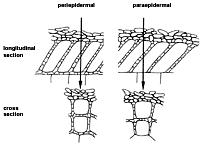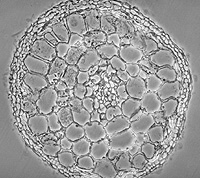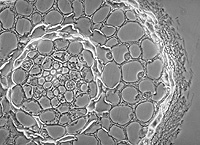Longtitudinal sections are more informative than cross-sections. There are hardly any features in cross-sections which cannot be observed in an identical or even in a better manner in longitudinal sections. Regarding the deepness of the Hartig net, longitudinal sections are even paramount to cross-sections, particularly if the cortical cells enveloped by the Hartig net are oriented in an oblique way (A). the reason is, that in cross-sections several cortical cell rows can appear to have a Hartig net, in spite of only a single row being envolved. Therefore, if only one kind of sections is addressed, then longitudinal sections should positively be preferred.
The dimensions of tannin cells are extremely variable depending upon their distance from the root tip, and whether they are formed by the outer row or by the second row of root cells, and also regarding the tree genus involved in the formation of ectomycorrhizae. Up to now, only very limited information is available about the influence of the fungus on the shape of tannin cells. The dimensional variability of cortical cells enveloped by a Hartig net is, however, less extended than that of tannin cells. To date, it seems that the shape of cortical cells in cross-sections cannot - in contrary to that of longitudinal sections - be used to distinguish host genera. As it is very time-consuming to take these measurements, and since presently these values seem to be of very limited use to distinguish between ectomycorrhizae formed by different fungi on the same host, these measurements may be left unconsidered. But for a complete description of an ectomycorrhiza somebody might be or might have been inclined to consider the dimensions of these cells, and possibly in the future some differences could indeed be detected which are possibly useful for a delimitation of species.
Only those sections should be regarded as cross-sections where the central cylinder with xylem elements can be seen (B–C).
 A |
 B |
 C |